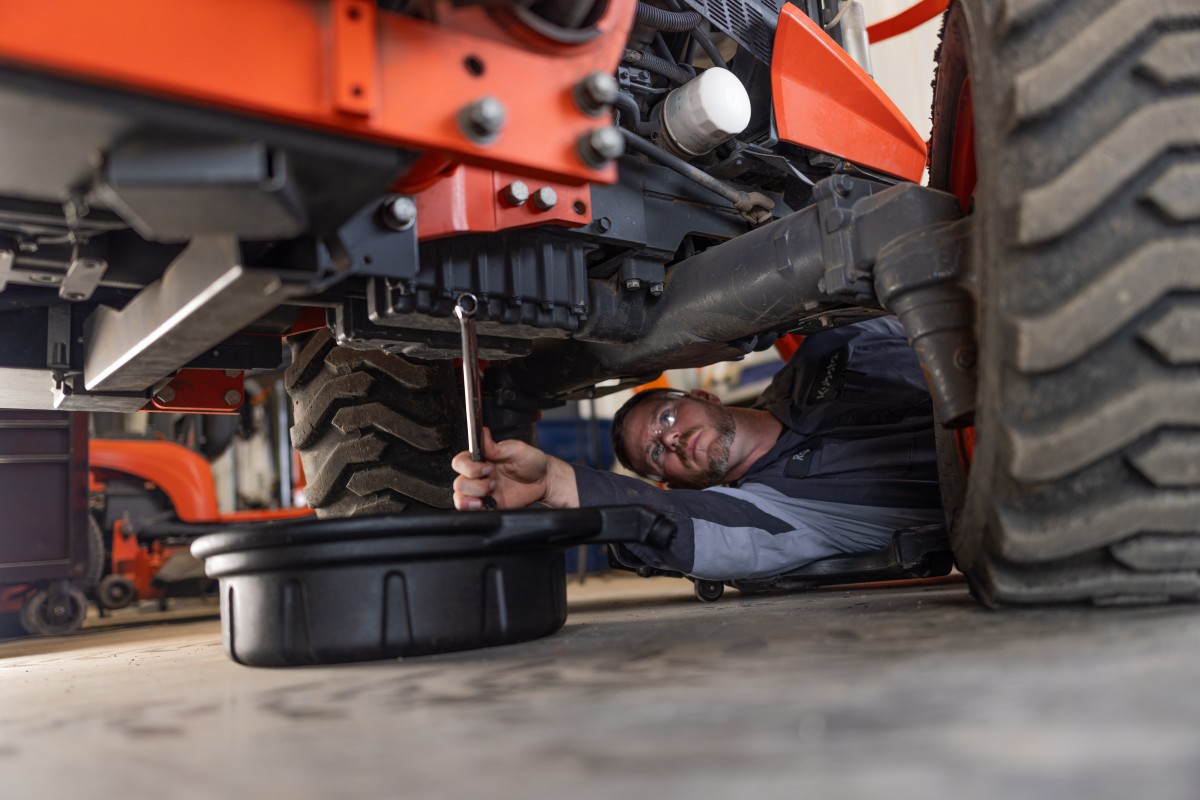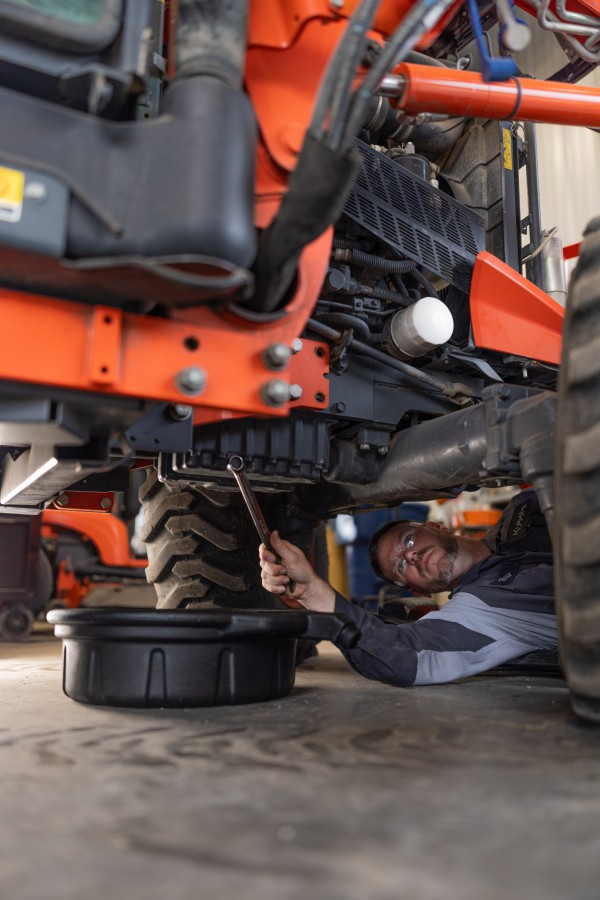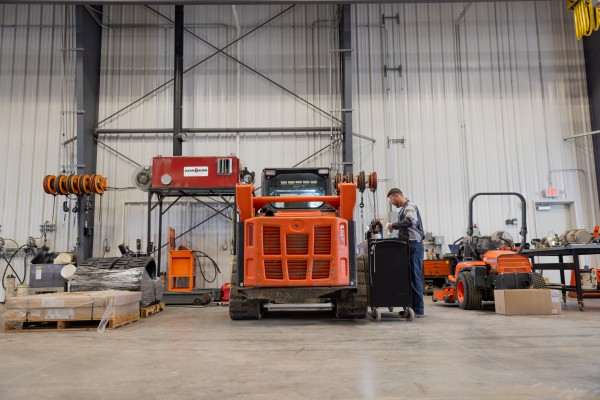
Kubota machinery, such as tractors, excavators, or mowers, requires proper care to perform reliably and efficiently over an extended period. With its renowned performance and durability, routine maintenance and smart operation can save time and prevent costly repairs.
To keep your Kubota machinery running at its best, a consistent maintenance schedule paired with best practices is essential. These efforts enhance equipment ROI and promote equipment longevity, whether for heavy-duty tractors or specialized tools.
8 Steps to Extend the Life of Your Kubota Machinery
Maximizing equipment longevity for your Kubota machinery requires effort, but the payoff is worth it. Here are eight steps to ensure your equipment stays in top condition.
1. Follow a Routine Maintenance Schedule
A structured maintenance schedule prevents performance issues and unexpected breakdowns, extending the life of your Kubota machinery. Kubota provides specific guidelines, and adhering to them ensures optimal performance, reduces repair costs, and maintains efficiency year-round. Break tasks into weekly, monthly, and seasonal checklists for simplicity.
Weekly Maintenance
Quick weekly checks catch minor issues early, keeping your Kubota machinery in peak condition with minimal time investment.
-
Inspect fluid levels: Check engine oil, hydraulic fluid, and coolant, topping off as needed.
-
Clean air filters: Remove dust and debris to maintain airflow and performance; replace if necessary.
-
Check tire pressure: Ensure proper inflation for stability and even wear.
-
Lubricate moving parts: Grease fittings, joints, and linkages to reduce wear.
-
Examine hoses and belts: Look for cracks, leaks, or looseness, addressing issues promptly.
Monthly Maintenance
Monthly tasks take a deeper approach to prevent long-term damage and sustain equipment longevity.
-
Replace engine oil and filters: Use Kubota-recommended oil to keep the engine running smoothly and prevent overheating.
-
Inspect and tighten bolts and fasteners: Counter vibrations by ensuring all connections are secure.
-
Test the battery: Check terminals for corrosion and confirm the battery holds a charge; clean if needed.
-
Drain water separator: Remove water from the fuel/water separator to protect the engine.
-
Evaluate hydraulic systems: Inspect hoses, fittings, and fluid levels for leaks and smooth operation.
Seasonal Maintenance
Prepare your Kubota machinery for seasonal challenges to maintain performance.
-
Spring Preparation: Check cooling systems, replace worn tires, and ensure readiness for increased workloads post-winter.
-
Summer Readiness: Clean radiators and cooling systems to avoid overheating; lubricate parts and monitor heat stress.
-
Fall Checkups: Clean fuel systems, replace air filters, and prep for reduced use or storage.
-
Winterizing Equipment: Drain fuel or add stabilizers to prevent gelling, verify antifreeze levels, and store batteries in a controlled environment if unused with Winterizing your Kubota equipment.
2. Maintaining Equipment Cleanliness
Keeping Kubota machinery clean is vital for equipment longevity.
Dirt and Debris
Dust and debris can clog air filters and other components, reducing performance. Regular cleaning prevents these issues.
Washing Practices
Use a pH-neutral soap and appropriate pressure to clean your machinery’s exterior, avoiding damage to sensitive parts.
Park in a Clean, Dry Area
Storing Kubota machinery in a dry, sheltered location protects it from moisture and dirt, preventing rust and decay.
3. Use High-Quality Fuel and Lubricants

High-quality fuel and lubricants are crucial for equipment longevity in Kubota machinery.
Impact of Fuel Quality on Performance
Poor fuel with impurities clogs injectors, reducing engine efficiency. High-grade fuel enhances combustion, improving economy and preventing buildup.
Choosing the Right Lubricants
Kubota-approved lubricants reduce friction in engines and hydraulics, preventing overheating and early wear. Check oil levels regularly and replace as per guidelines.
Role of Filters in Fuel Efficiency
Fuel and oil filters protect components from contaminants. Dirty filters strain engines, lowering efficiency. Regular filter maintenance ensures smooth operation and fuel economy.
4. Inspect and Replace Worn Parts
Regular inspection and replacement of worn parts are key to equipment longevity for Kubota machinery.
Common Signs of Wear
Check for cracks, frayed edges, or excessive vibration in moving parts like chains, belts, and bearings. Replace components showing these signs immediately.
Repair vs Replace
While minor damage can be repaired, heavily worn parts should be replaced to prevent further harm. Delaying replacements risks costly breakdowns.
Using Genuine Kubota Parts
Use genuine Kubota parts for reliability and compatibility. Generic or low-quality parts may misfit, reduce performance, or void warranties.
5. Proper Storage and Protection
Proper storage enhances equipment longevity for Kubota machinery.
Best Practices for Off-Season Storage
For long-term storage, drain fuel to prevent clogs, grease exposed parts, and cover the equipment to shield it from dust and moisture.
Shielding Equipment from Weather Extremes
Heat, cold, or humidity can damage hydraulic and electrical systems. Store machinery in a temperature-controlled space or use insulation to protect against weather effects.
6. Operate Machinery Correctly

Correct operation is critical for equipment longevity in Kubota machinery.
Train Operators for Appropriate Use
Improper use often causes machinery issues. Ensure operators are trained to handle Kubota machinery properly, avoiding strain from exceeding operational limits.
Avoiding Common Mistakes
Aggressive handling, overloading, or skipping warm-up and cool-down routines shortens equipment life. Follow Kubota’s instructions for best results.
Following Manufacturer Guidelines
Kubota’s manuals provide detailed use and maintenance instructions. Adhering to these protects warranties and enhances durability.
7. Monitor and Adjust Tire Pressure
Maintaining proper tire pressure supports equipment longevity for Kubota machinery.
Effects of Improper Tire Pressure
Low pressure increases rolling resistance, straining engines and reducing fuel efficiency. Over-inflation causes uneven wear and poor traction.
Checking and Maintaining Optimal Pressure
Use a reliable gauge to monitor tire pressure regularly, adjusting it to Kubota’s specifications for terrain and load conditions.
8. Keep Electrical Systems in Check
Electrical system maintenance is vital for equipment longevity in Kubota machinery.
Inspecting Batteries, Wiring, and Connections
Regularly inspect battery terminals for corrosion, secure loose wires, and replace frayed cables to prevent failures.
Preventing Electrical Failures
Loose or weak connections can disrupt functions like navigation. Routine checks ensure reliability.
Proper Storage of Battery-Powered Equipment
For battery-powered Kubota machinery, detach batteries during long storage and keep them in a cool, dry place to minimize degradation.
How to Handle Emergency Repairs
Unexpected breakdowns in Kubota machinery can disrupt work, but a smart approach minimizes downtime and costs. Here are steps to manage emergency repairs effectively:
-
Use a Repair Kit: Keep a basic tool kit with wrenches, screwdrivers, fuses, and a spare tire for quick fixes.
-
Contact a Professional If Needed: For complex issues, call a Kubota service expert for troubleshooting or on-site help.
-
Take Preventive Measures for Future Emergencies: Post-repair, perform regular maintenance and monitor wear to avoid repeats.
-
Record the Incident: Document the cause, repair process, and parts needed to guide future maintenance.
-
Know Your Warranty Coverage: Check your warranty before major repairs to ensure covered costs aren’t overlooked, enhancing equipment longevity.
4 Overlooked Errors That Could Potentially Shorten the Lifespan of a Machine
Despite their durability, small mistakes can reduce equipment longevity in Kubota machinery. Beyond obvious errors like skipping maintenance or using poor fuel, these overlooked issues can lead to costly repairs or inefficiency:
1. Idling the Engine for an Extended Period
Prolonged idling causes incomplete combustion and carbon buildup, reducing fuel efficiency and wearing internal components. Turn off the engine when idle for more than a few minutes.
2. Not Using the Correct Attachments
Using incompatible attachments strains machinery, causing premature wear. Always verify compatibility with Kubota specs to protect components.
3. Neglecting Bolts and Fasteners
Vibrations loosen bolts and fasteners over time. Ignoring regular checks can lead to instability and breakdowns. Routine tightening prevents damage.
4. Ignoring Cooling System Maintenance
Failing to monitor coolant levels or clean radiators risks overheating, accelerating wear or engine failure. Regular maintenance keeps the system effective.
Enjoy Kubota Machinery For a Lifetime
A maintenance schedule, quality fuel and lubricants, proper storage, and correct operation ensure your Kubota machinery performs at its peak for years, maximizing equipment longevity.
Avoiding common mistakes like excessive idling, neglecting cooling systems, or delaying part replacements prevents costly repairs and downtime. Small habits yield big results.
H&R Agri-Power is here to support your Kubota machinery needs with servicing and maintenance expertise. Contact us today to keep your equipment in top shape!

